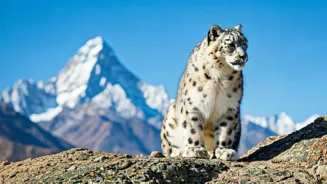Snow Leopard's Domain
The elusive snow leopard, a symbol of the Himalayas, reigns supreme in this challenging environment. This magnificent big cat, with its smoky-gray fur
and powerful build, is perfectly adapted to survive the harsh conditions of high-altitude terrains. Their thick fur provides insulation against the extreme cold, and their large paws act like snowshoes, allowing them to navigate deep snow. Hunting blue sheep and other ungulates is their specialty, making them crucial predators in this ecosystem. However, their survival is threatened by habitat loss and poaching, which has led to significant population decline. Conservation efforts are underway to protect their habitat and reduce human-wildlife conflict, ensuring the snow leopard's continued presence in the Himalayas. Understanding and respecting their habitat is essential for their survival, ensuring these majestic creatures continue to thrive in this unique ecosystem.
Red Panda's Habitat
The adorable red panda, often mistaken for a raccoon, is a charming resident of the Eastern Himalayas. Its vibrant reddish-brown fur and bushy tail are perfectly suited for life in the forests. These animals primarily feed on bamboo but are also known to consume fruits, eggs, and insects. Red pandas live in high-altitude forests, where they climb trees with ease. Sadly, their numbers are dwindling due to habitat loss and fragmentation, driven by deforestation and human expansion. Conservation initiatives, including protected areas and community-based conservation programs, are helping to safeguard red panda habitats and increase their populations. Preserving the red panda's home means ensuring that the bamboo forests thrive, providing them with food and shelter.
Blue Sheep's Ascent
Blue sheep, or bharal, are an important part of the Himalayan ecosystem, providing a food source for predators like snow leopards. Despite their name, their coat appears more slate-gray in color. Their strong legs and hooves enable them to navigate the rugged terrain, making them exceptional climbers. They graze on grasses and herbs found in high-altitude meadows. They have adapted to the extreme temperatures, with thick fur that protects them from the cold. Unfortunately, habitat loss and hunting pose threats to blue sheep populations, leading to population declines in some areas. Conservation efforts like habitat protection and anti-poaching measures help maintain the delicate balance of the Himalayan ecosystem.
Himalayan Monal's Beauty
The Himalayan monal, or impeyan pheasant, is a bird known for its stunning iridescent plumage. Males boast vibrant colors, including shades of green, red, and purple, while females have a more subdued appearance. They forage for food on the ground, eating seeds, berries, and insects. They are found in the forests and meadows of the Himalayas and play a vital role in seed dispersal. Despite habitat destruction and hunting for feathers and meat, efforts are underway to protect the monal's habitat. Conservation strategies are important to safeguard their numbers and ensure they can thrive in the natural world.
Musk Deer's Secrets
The Himalayan musk deer is famous for producing musk, a substance used in perfumes. It is a small deer with long canines, living in high-altitude environments with dense forests. They live solitary lives, feeding on herbs and shrubs. Due to its valuable musk, these animals have been overhunted, leading to a decrease in population. Preserving their habitat and enforcing anti-poaching laws are essential for their protection. Conservation actions focus on maintaining the musk deer population and creating an environment where it can flourish.
Takin's Stronghold
The takin, also called the cattle chamois, is a unique, sturdy animal with a distinctive appearance. It has a muscular build and a thick coat to withstand the freezing temperatures. They live in small herds, grazing on grasses and leaves in high-altitude environments. Takins can be found in the eastern Himalayas. The main threats to the takin are habitat loss and hunting. This has led to population decline in the wild. Conservation efforts involve protecting their habitat and promoting sustainable practices to ensure the Takin thrives in the high-altitude environments.
Black Bear's Lifestyle
The Himalayan black bear, also known as the Asiatic black bear or moon bear, is recognized by its distinctive white chest marking. They are excellent climbers and spend a lot of time in the trees, foraging for fruits, nuts, and insects. They are important seed dispersers and play a critical role in maintaining forest health. Habitat loss, deforestation, and poaching threaten the black bear's survival. Conservation initiatives are essential for habitat preservation, reducing human-wildlife conflicts, and protecting their numbers to ensure these majestic bears continue to roam the Himalayas.
The Tibetan Wolf
The Tibetan wolf, a subspecies of the gray wolf, is a vital predator in the Himalayan ecosystem. Their thick fur and strong bodies are built to survive the cold winters. They usually hunt in packs, preying on animals like blue sheep and marmots. Habitat loss, human-wildlife conflict, and diseases threaten the Tibetan wolf. Conservation measures focus on protecting their habitat and promoting coexistence with human populations. Preservation of the Tibetan wolf helps keep the natural balance of the Himalayas intact.
The Marmot's World
Himalayan marmots are large ground squirrels that live in colonies in the high-altitude meadows. They spend much of their time underground in burrows. They are herbivores, feeding on grasses and herbs. They are also a vital food source for predators like snow leopards. Habitat loss and climate change threaten their survival. Conservation strategies involve preserving their habitat and adapting to changing environmental conditions. These efforts support a thriving marmot population.
The Lynx's Secret
The elusive Eurasian lynx, also found in the Himalayas, is a stealthy predator with tufted ears and a short tail. It is well-adapted to hunt in rocky terrains and forests, preying on smaller mammals and birds. Their unique spotted coat provides camouflage. They have adapted to low-oxygen environments. Their survival is threatened by habitat loss and poaching. Protecting their habitat is key to the survival of the lynx and also a broader biodiversity conservation strategy. The lynx's presence is a sign of a healthy and diverse Himalayan ecosystem.

